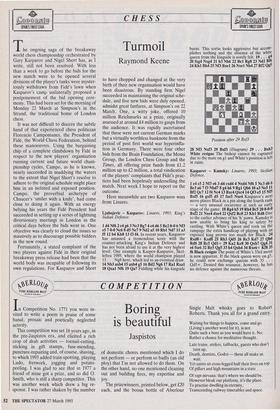Turmoil
Raymond Keene
The ongoing saga of the breakaway world chess championship orchestrated by Gary Karparov and Nigel Short has, as I write, still not been resolved. With less than a week to go before the bids for the new match were to be opened several divisions of the player's tanks were myster- iously withdrawn from Fide's lawn when Kasparov's camp unilaterally proposed a postponement of the bid opening cere- mony. This had been set for the morning of Monday 22 March at Simpson's in the Strand, the traditional home of London chess.
It was not difficult to discern the subtle hand of that experienced chess politician Florencio Campomanes, the President of Fide, the World Chess Federation, behind these manoeuvres. Using the bargaining chip of a complete climbdown by Fide in respect to the new players' organisation running current and future world cham- pionship cycles, Campo, as he is known, nearly succeeded in muddying the waters to the extent that Nigel Short's resolve to adhere to the original schedule might place him in an isolated and exposed position. Campo, the proverbial archetype of Chaucer's 'smiler with a knife', had come close to doing it again. With an energy belying his years the Fide President had succeeded in setting up a series of lightning diversionary meetings in London in the critical days before the bids went in. One objective was clearly to cloud the issues so massively as to discourage possible bidders in the new round.
Fortunately, a stated complaint of the two players against Fide in their original breakaway press release had been that the world body was incapable of following its own regulations. For Kasparov and Short to have chopped and changed at the very birth of their new organisation would have been disastrous. By standing firm Nigel succeeded in maintaining the original sche- dule, and five new bids were duly opened, admidst great fanfares, at Simpson's on 22 March. One, a witty joke, offered 10 million Reichmarks as a prize, originally assessed at around £4 million to gasps from the audience. It was rapidly ascertained that these were not current German marks but a virtually worthless banknote from the period of post first world war hyperinfla- tion in Germany. There were four other bids from the Brain Foundation, the Monsi Group, the London Chess Group and the Times, all offering prize funds from £1.2 million up to £2 million, a total vindication of the players' complaints that Fide's prac- tices had been hopelessly underselling the match. Next week I hope to report on the outcome.
Here meanwhile are two Kasparov wins from Linares.
Ljubojevic — Kasparov: Linares, 1993; King's
Indian Defence.
d4 Nf6 2 c4 g6 3 Nc3 Bg7 4 e4 d6 5 Be2 0-0 6 Nf3 e5 70-0 Nc6 8 d5 Ne7 9 Nd2 a5 10 Rbl Nd7 11 a3 f5 12 b4 Kh8 13 13 f4. In recent years, Kasparov has amassed a tremendous score with the counter-attacking King's Indian Defence and has not been afraid to use it at the very highest level. One example is Karpov-Kasparov, Skel- leftea 1989, where the world champion played 13. . .Ng8 here, which led to an eventual draw. 14 Nb3 axb4 15 axb4 g5 16 Bd2 Ng6 17 Ral Rxal 18 Qxal Nf6 19 Qa7 Fiddling while his kingside burns. This sortie looks aggressive but accom- plishes nothing and the absence of the white queen from the kingside is sorely felt. 19. . . g4 20 fxg4 Nxg4 21 h3 Nh6 22 Bel Rg8 23 Nd2 Bf6 24 Khl Bh4 25 Nf3 Bxel 26 Nxel Nh4 27 Rf2 Q85
Position after 29 Bxli
28 Nf3 Nxf3 29 Bx13 (Diagram) 29 . . . Bxh3 White resigns The bishop cannot be captured due to the mate on gl and White's position is left in ruins.
Kasparov — Karnsky: Linares, 1993; Sicilian
Defence.
1 e4 c5 2 NO e6 3 d4 cxd4 4 Nxd4 Nf6 5 Nc3 d6 6 Be3 a6 7 f3 Nbd7 8 g4 h6 9 Rgl Qb6 10 a3 Ne5 11 Bf2 Qc712 f4 Nc4 13 Bxc4 Qxc4 14 Qf3 e5 15 Nf5 Bxf5 16 gxf5 d5 17 fxe5 Nxe4 Kasparov's next. move places Black in a pin along the fourth rank — a very unusual occurence at such an early stage of the game. 18 Rg4 h5 19 Rh4 Bc5 200.0-0 Bxf2 21 Nxe4 dxe4 22 Qx12 Rc8 23 Kbl Rd8 Due to the earlier advance of his 'h' pawn, Kamsky is now unable to bring his king to safety by castling. With White's queen and rook on the rampage the extra handicap of playing with all exposed king proves too much for Black. 24 Rxd8+ Kxd8 25 Rh3 Qd5 26 Rc3 Kd7 27 Qb6 Rd8 28 Rc5 Qdl+ 29 Ka2 Ke8 30 Qxb7 Qg4 31 e6 fxe6 32 Re5 Qg5 33 h4 Qxh4 34 Rxe6+ Kf8 35 f6 Black resigns The point of White's 33rd move is now apparent. If the black queen were on g5, he could now exchange queens with 35 . • • Qd5+. Denied this resource, however, he has no defence against the numerous threats.


























































 Previous page
Previous page